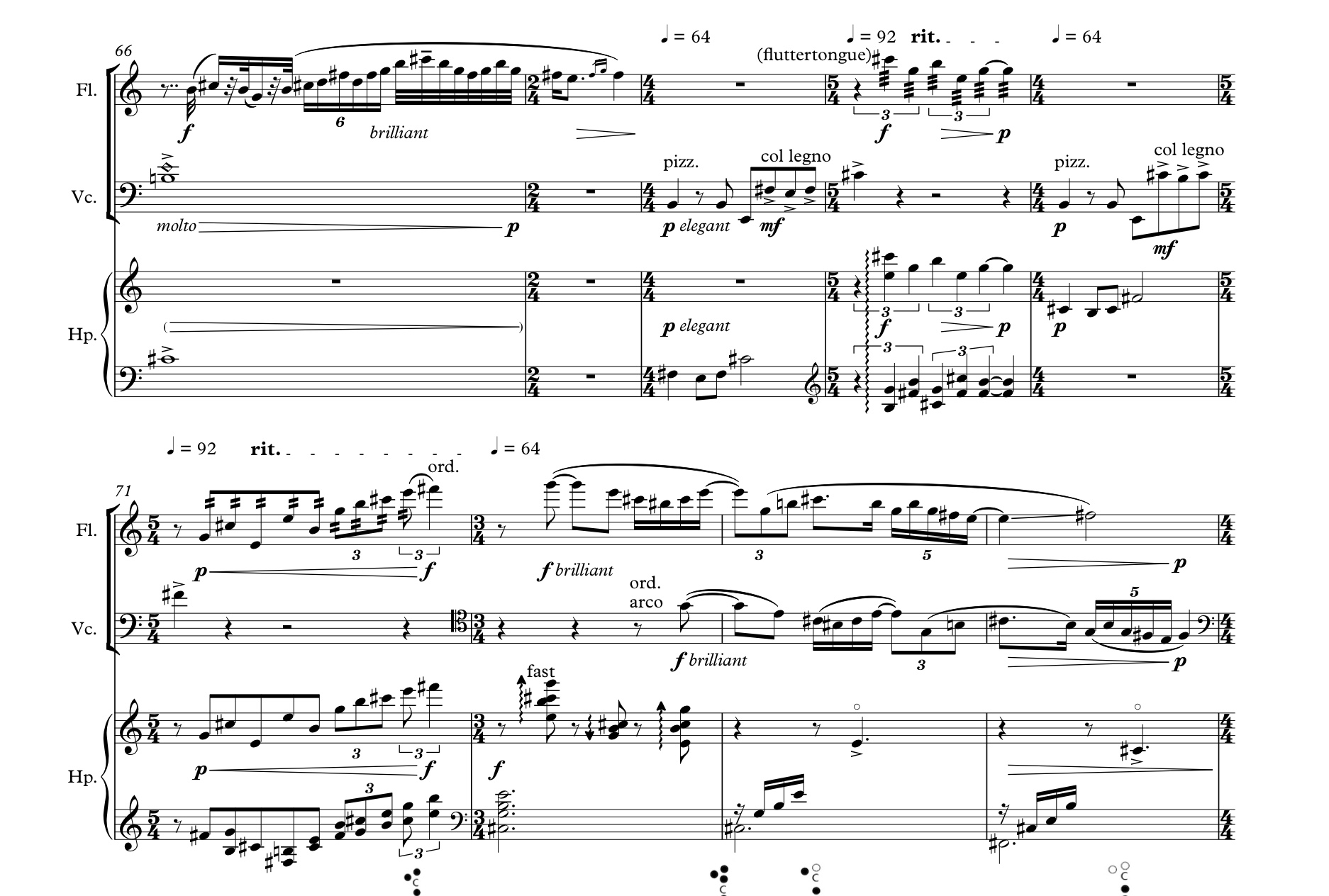












Music University of Cambridge
Music University of Cambridge

Ruriko-in, November 2017
2563
11 นาที 48 วินาที
Ruriko-in, November 2017
2020
11 minutes 48 seconds
แรงบันดาลใจสำหรับผลงานชิ้นนี้มาจากประสบการณ์ส่วนตัวของผู้แต่ง ในช่วงฤดูใบไม้ร่วงปี 2017 ผู้แต่งได้ไปเยี่ยมชมวัด Rurikō-in ในเมืองเกียวโต ในวัดนั้นผู้แต่งได้เห็นทิวทัศน์ที่สวยงามที่สุดเท่าที่ผู้แต่งเคยเห็นมาในชีวิตในขณะนั้น ในวัดเป็นระเบียงไม้ที่มองออกไปเห็นสวนต้นเมเปิ้ลและแปะก๊วยสีเหลืองและแดงอร่าม เต็มไปด้วยแสงสีสะท้อนที่ตกลงมาบนโต๊ะไม้เคลือบด้านหน้า ทำให้เห็นทั้งแสง เงาสะท้อนและความมืดให้เห็นอย่างเต็มตา ผู้แต่งรู้สึกมีความสุขเป็นอย่างมากในการนั่งมองและครุ่นคิดถึงธรรมชาติที่อยู่ตรงหน้า แต่เมื่อเริ่มเห็นใบเมเปิ้ลร่วงลงมาจากต้นทีละใบอย่างง่ายดายแม้กระทั่งในสายลมอ่อนๆ ผู้แต่งก็เศร้าใจทันทีที่ตระหนักได้ว่าความงามของธรรมชาติที่กำลังมองดูอยู่ ถึงแม้จะมีความยิ่งใหญ่และอลังการขนาดไหน ก็จะคงอยู่ไม่นานและจะหมดไปอย่างสมบูรณ์ภายในสิ้นฤดูใบไม้ร่วงปีนั้น ตั้งแต่วันนั้นที่วัด Rurikō-in ผู้แต่งก็ได้รู้สึกเข้ามาใกล้กับความเข้าใจและการยอมรับในคำสอนของพระพุทธเจ้าเกี่ยวกับสัจธรรมของอนิจจังในธรรมชาติ หรือความไม่เที่ยง (mujō ในภาษาญี่ปุ่น) มากยิ่งขึ้น ซึ่งมันเป็นอะไรที่ผู้แต่งได้ยินมาโดยตลอด แต่ไม่เคยรู้สึกถึงในระดับอารมณ์อย่างลึกซึ้งขนาดนั้นมาก่อน พระพุทธเจ้าทรงสอนว่าสิ่งไหนที่มีอยู่ในตอนนี้ สุดท้ายก็จะเปลี่ยนรูปหรือหายไป เราหาความยั่งยืนถาวรไม่ได้ในธรรมชาติเลย ความงามสง่าของฤดูใบไม้ร่วงนั้น ทำให้เราเข้าใจผิดในรูปลักษณ์ของความมั่นคงของมัน ความจริงคือมันอยู่ในพลวัตของการเปลี่ยนแปลงอยู่ตลอดเวลา นี่คือสิ่งที่พระชื่อ ”โดเก็น” จากญี่ปุ่นได้สอนไว้เรื่องการ “ไหล” ของธรรมชาติไปในทิศทางของการเติบโต หรือการสลายตัว อย่างในกรณีนี้ ความเข้าใจในจุดนี้ได้ช่วยให้ฉันหันมาเข้าใจและชื่นชมสุนทรียศาสตร์วาบิซาบิของญี่ปุ่น ซึ่งมุ่งเน้นไปที่การยอมรับในความไม่เที่ยง ในขณะที่แสวงหาและชื่นชมความงดงามในนั้น ที่ปนไปด้วยความเศร้าหมองอยู่เนืองๆ ความคิดเหล่านี้กลายเป็นศูนย์กลางของโลกทัศน์ของผู้แต่งในฐานะนักแต่งเพลงตั้งแต่ตอนนั้นมา ดังนั้นผู้แต่งจึงได้รับแรงบันดาลใจให้เขียนงานชิ้นนี้เพื่อสร้างเรื่องราวเกี่ยวกับประสบการณ์และความรู้สึกในวันนั้นที่วัด Rurikō-in ในวันนั้น เพื่อแสดงถึงความสุขที่เอ่อล้นแต่ปนไปด้วยความเศร้าตอนกลับจากวัด โดยเริ่มจากการได้สัมผัสกับความงดงามอันยิ่งใหญ่ของฤดูใบไม้ร่วงที่อยู่ภายนอก ไปจนถึงการนึกขึ้นได้อย่างฉับพลันเรื่องความไม่เที่ยงของธรรมชาติ และการไตร่ตรองภายในความคิดตัวเองที่ตามมา ซึ่งผลงานชิ้นนี้เป็นโอกาสที่ดีสำหรับผู้แต่งในการสำรวจแง่มุมต่างๆของดนตรีเชมเบอร์ดนตรีญี่ปุ่น สุนทรียศาสตร์ญี่ปุ่น และศาสนาพุทธ ซึ่งทั้งหมดนี้ผู้แต่งรัก
My inspiration for this piece came from a very specific personal experience. During the autumn of 2017 I visited Rurikō-in Temple in Kyoto. While there, I witnessed possibly the most beautiful sight I ever saw in my life - a dark wooden corridor overlooking a garden of maple and gingko trees in full autumn colours, reflecting vividly onto the lacquered tables inside, filling the entire field of vision with light, shadow and colours. I had a purely joyful moment taking in the sight when I started seeing maple leaves fall from the tree so easily in gentle wind. Suddenly I became saddened at the realisation that the beauty of the nature that I was looking at was so majestic yet so fragile and transient, that it would not last for a long time, and would be completely gone by the end of autumn that year. From that day at Ruriko-in I felt closer to understanding and accepting the Buddha’s teaching on the truth of Anitya, or impermanence (mujo in Japanese), which I always hear about but never truly felt on an emotional level before. Whatever exists now will either transform or evanesce. The majestic beauty of nature is deceptive in its appearance of stability, and is always in a dynamic state of constant change, or “flow”, going in the direction of growth or, in this case, decay. That therefore helped me embrace the Japanese wabi-sabi aesthetics, which focuses on accepting impermanence while seeking and appreciating the melancholic beauty in it. These ideas had since become the centre of my worldview as a composer. I was therefore inspired to write this piece as an account of my experience at Ruriko-in Temple on that day, and to express the blissful yet profoundly melancholic feeling with which I left it, going from experiencing the immense, external beauty of autumn towards the sudden realisation and internal contemplation on its transience. The piece was a great opportunity for me to explore aspects of chamber music, Buddhism, Japanese music and Japanese aesthetics, all of which I love very deeply.
ในผลงานชิ้นนี้ ผู้แต่งได้เล่าและแสดงถึงความรู้สึกต่างๆที่มีในขณะนั่งอยู่ในวัด Rurikō-in ณ เมืองเกียวโตในฤดูใบไม้ร่วง และได้มองเห็นความงามและสีสันของธรรมชาติในสวนที่อยู่ด้านนอก (สามารถดูตามรูปถ่ายที่แนบมาในสกอร์) โครงสร้างของเพลงเป็นไปตามลำดับการพินิจพิเคราะห์แต่ละองค์ประกอบของทิวทัศน์ในวัดโดยผู้แต่งในตอนนั้น โดยเริ่มจากความมืดไปสู่แสงสว่าง จากภายในสู่ภายนอก จากความไม่เป็นระเบียบที่มากับเงาและความมืด (chaos) ไปสู่ความเป็นระเบียบของธรรมชาติที่อยู่ภายนอก (natural order) ซึ่งในกรณีนี้หมายถึงจากเงามืดที่อยู่ในตัววัด ไปสู่แสงสะท้อนริบหรี่ที่อยู่บนโต๊ะเคลือบที่อยู่ตรงหน้า และในที่สุด ไปสู่สีสันสวยงามของฤดูใบไม้ร่วงที่อยู่ด้านนอก สุดท้ายเพลงนี้จบลงด้วยการที่ความสุขในการมองดูธรรมชาติที่เอ่อล้นขึ้นเรื่อยๆพลันสลายไปสู่การตระหนักถึงความไม่เที่ยงของมันในทันที จนไปถึงการไตร่ตรองถึงความอนิจจังที่ปนด้วยความเศร้าหมองอย่างสุดซึ้งที่ตามมาโดยผู้แต่ง ทำให้เพลงชิ้นนี้สามารถแบ่งออกเป็น 4 ส่วน ได้แก่ “The Shadows" "The Reflection" "The Autumn Colours" และ "The Realisation" จุดมุ่งหมายในการสร้างทิศทาง (sense of direction) ในเพลงนี้คือการเริ่มจากการสร้างความรู้สึกสงบและอยู่นิ่งซึ่งแฝงไปด้วยความไม่เป็นระเบียบที่อยู่ภายใต้เงามืด (darkness and chaos) และเมื่อเพลงดำเนินไปเรื่อยๆ ก็จะค่อยๆปลูกฝังระเบียบในจังหวะและไอเดีย ความสว่างในเนื้อเสียง และความรู้สึกที่ไปข้างหน้ามากขึ้น (ในขณะที่แสงสว่าง ความเป็นระเบียบในธรรมชาติ และความสุขในตัวผู้แต่งเพิ่มขึ้นเรื่อยๆในเวลากัน) และจบลงด้วยการพังทลายของความรู้สึกนั้น กลับสู่ความสงบนิ่งที่แฝงด้วยความเศร้าและไร้ระเบียบ ซึ่งคอนเซ็ปต์ของ Jo-ha-kyū ในศิลปะดั้งเดิมของญี่ปุ่นนั้นเหมาะสมในการนำมาปรับใช้สร้างทิศทางในเพลงนี้ โดยใน Jo-ha-kyū นั้น ดนตรีจะเปลี่ยนจากสภาวะที่อยู่นิ่งๆ โดยค่อยๆได้รับแรงผลักดันจากจังหวะเพิ่มขึ้นเรื่อยๆ และจบลงอย่างรวดเร็ว ผู้แต่งปรับแนวคิดนี้นำมาใช้อย่างอิสระใน 3 ส่วนแรกของเพลง และได้นำแนวคิด Jo กลับมาใช้เป็นพื้นฐานสำหรับส่วนสุดท้ายด้วย และนำมาสู่โครงสร้าง Jo-ha-kyū-Jo ของทั้งเพลงที่สร้างขึ้นเอง โครงสร้างนี้เกือบจะสมมาตร แต่ไม่สมมาตร ซึ่งสอดคล้องกับสุนทรียศาสตร์แบบวาบิซาบิเป็นอย่างดี ซึ่งเน้นความสวยงามในความไม่สมมาตรซึ่งมีความเป็นธรรมชาติ ในส่วนที่ชื่อ “The Shadows” ผู้แต่งได้รับอิทธิพลจากหนังสือ “เยิรเงาสลัว” (In Praise of Shadows) ของ Jun’ichirō Tanizaki ในการค้นหา ชื่นชมและแสดงออกถึงความงามในแสงสลัวและเงา ซึ่งเป็นสิ่งที่มีค่ามากในศิลปะญี่ปุ่น แต่มักจะถูกมองข้ามในศิลปะตะวันตก ในส่วนนี้ของเพลงจะให้ความรู้สึกเหมือนเป็น improvisation แบบที่ถูกควบคุมไว้หลวมๆโดยไม่มีจังหวะที่แน่นอน ซึ่งแสดงถึงความไม่มีระเบียบภายใต้ความมืด ผู้แต่งนำสเกลญี่ปุ่น in scale เป็นพื้นฐาน แต่ไม่ใช้สเกลในส่วนนี้เลยในท่อนนี้ และหันไปใช้ชุดโน้ต hexachord ตรงข้ามกับมันที่อยู่ในสเกลโครมาติกแทน ให้เป็น "เงา" ของสเกลญี่ปุ่นในทางสัญลักษณ์ ผู้แต่งนำเสนอโมทีฟต่างๆในตอนแรกนี้ ซึ่งจะเปิดเผยว่าโมทีฟส่วนใหญ่นั้นมีความเกี่ยวข้องกันในส่วนสุดท้ายของเพลง (ส่วนมาก 3 โน้ตแรกประกอบด้วย 2 ascending intervals สั้นและยาวตามลำดับ) แต่ละโมทีฟมีความหมายเชิงสัญลักษณ์ทั้งหมด แต่อันที่น่าสังเกตอันหนึ่งคือโมทีฟที่เป็น diatonic chord 2 คอร์ด ตามด้วยคอร์ดเสียง dissonant ที่เจอในฮาร์ป โมทีฟนี้มีขึ้นและลง จากความบริสุทธิ์กลายเป็นความไม่บริสุทธิ์ แสดงถึงความอนิจจัง การเติบโตและการสลายตัว ลักษณะการที่ส่วนนี้ของเพลงมีความรู้สึกหยุดนิ่ง ไร้แรงผลักดันไปข้างหน้า ทำให้ผู้แต่งสามารถสร้างความหมายให้โมทีฟต่างๆในหลากหลายรูปแบบ สร้างความเข้าใจให้โมทีฟต่างๆในหลากหลายมุมมอง เพื่อสื่อถึงความสงบนิ่งและการพินิจพิเคราะห์ทิวทัศน์ที่อยู่ในความคิดของผู้แต่งในขณะนั้น เมื่อท่อนนี้ดำเนินไปเรื่อยๆ ก็มีการเพิ่ม pitch ขึ้นเรื่อยๆทีละตัวจนมีครบ 12 ตัว แสดงถึงแสงริบหรี่ที่ค่อยๆเล็ดลอดเข้ามาในวิสัยทัศน์ของผู้แต่ง เมื่อค่อยๆขยับสายตาไปมองแสงสะท้อนบนโต๊ะ ผู้แต่งได้ใช้ฮาร์โมนิกส์มากมายในเครื่องดนตรีทั้ง 3 ชนิดในท่อนนี้เพื่อสร้าง soundscape ที่แสดงถึง "เงา" ของตัวตนของเสียงที่ปกติของเครื่องดนตรีเหล่านี้ ในท่อน “The Reflection” ผู้แต่งชื่นชมความงามที่อยู่ภายนอกที่เห็นได้อย่างคลุมเครือผ่านแสงสะท้อนที่ตกลงมาบนโต๊ะด้านในวัด ส่วนนี้มีการนำเสนอ pitch ทุกตัวและนำมาใช้อย่างอิสระ ผู้ฟังอาจได้ยินสำเนียงจังหวะดนตรีราชสำนักญี่ปุ่นโบราณ Gagaku และสำเนียงดนตรีพื้นบ้านญี่ปุ่น การสะท้อนของแสงในท่อนนี้ถูกแสดงออกมาโดยทั้งสองแบบ 1. เสียงที่สะท้อนพร้อมกันจากแกน ซึ่งเป็น pitch ตั้งต้น (simultaneous reflection of pitch from axis that is the initial pitch) หรือ 2. phrase สั้นๆติดกันที่สะท้อนกันและกัน (echo) ความงดงามที่มีความเป็นระเบียบของธรรมชาติ (natural order) ที่ผู้แต่งเห็นในแสงสะท้อนอย่างคลุมเครือ ถูก represent ในจังหวะดนตรีสไตล์ Kangen ที่มีความเนิบและสง่างาม ส่วน Ostinato ต่างๆ ก็เข้าๆออกๆจากเนื้อดนตรี เพื่อค่อยๆสร้างการเคลื่อนไหวไปข้างหน้าในจังหวะ ในท่อน “The Autumn Colours” ผู้แต่งรู้สึกสงบและมีความสุขมากขึ้นเรื่อยๆเมื่อได้ชมทิวทัศน์ฤดูใบไม้ร่วงที่อยู่ด้านนอก แนวคิดจังหวะบางอย่างจากดนตรี Gagaku ได้ถูกนำมาทดลองในท่อนนี้ เช่น การเร่งความเร็วทีละเล็กน้อยซึ่งผู้ฟังไม่สามารถรับรู้ได้ หรือเสียง downbeat ที่จงใจไม่ให้ลงตรงกันระหว่างเครื่องดนตรีต่างๆเล็กน้อยเพื่อให้เกิดเสียงที่ฟังดูเป็นธรรมชาติ รวมถึงการปรับเปลี่ยนนำ ostinato จังหวะสไตล์ดนตรี kangen มาใช้แบบอิสระ ผู้แต่งได้ผสมผสาน in scale จากดนตรีพื้นบ้าน และ hyōjō scale จากดนตรี gagaku อย่างอิสระ ดนตรีในท่อนนี้ได้มาถึงความมั่นคงในจังหวะและมีความสง่างาม (ด้วยความแตกต่างระหว่างอิสระในฟลูทและเชลโล่ และจังหวะที่มั่นคงในฮาร์ป) ซึ่งแสดงถึงระเบียบในธรรมชาติ (natural order) จังหวะค่อยๆเร็วขึ้นและมาถึง climax อย่างรวดเร็ว แต่ก็ถล่มลงมาทันทีในท่อน “The Realisation” ทุกอย่างกลับมากระจัดกระจายอีกครั้ง และแฝงด้วยอารมณ์ที่เศร้าหมองของการตระหนักถึงความไม่เที่ยงในธรรมชาติ และตอนสุดท้าย การเชื่อมโยงระหว่างโมทีฟต่างๆก็ถูกเผยให้เห็น
In this piece, I sought to express the progression of feelings I had while sitting in the corridor of Rurikō-in Temple, observing the immense natural beauty of the colours in the garden outside (see photo attached in the score). The structure follows my observation of each element of the scene, moving from dark to light, from inside to outside, and therefore from chaos to natural order - the dark shadows in the corridor, to the glimmering reflection of light onto the lacquered tables, finally to the vivid autumn colours. The piece ends with a section where the growing joy of observing the beauty of nature suddenly breaks down into a realisation of its impermanence and a deeply melancholic contemplation that follows. This creates 4 sections “The Shadows“, “The Reflection”, “The Autumn Colours“, and “The Realisation“. The aim is to at first create a sense of chaos in unmoving stillness, and as the piece progresses, instil a sense of forward momentum (as light, natural order, and my own joy grow), ending in a breakdown back to chaos and stillness. The principle of Jo-ha-kyū in traditional Japanese arts is appropriate in creating a linear progression here. In Jo-ha-kyū, music moves from a state of stillness, gradually gain momentum and end rapidly. I freely adapted this concept to represent the first 3 sections, and used the Jo concept as a basis for the last section, creating a Jo-ha-kyū-Jo structure. This structure, almost symmetrical but not quite, complies well with the wabi-sabi aesthetics, which emphasise the beauty in asymmetry. In “The Shadows“ section, I was influenced by Jun’ichirō Tanizaki’s book “In praise of shadows“ to find and express the beauty in dim light and shadows, which is prized in Japanese art but often overlooked in Western art. The section feels like a controlled improvisation, without tempo, representing the chaos of darkness. I used the traditional In scale as a basis, but used its complementary hexachord set instead, as a “shadow” of the Japanese scale. I introduced various motifs, most of which are revealed to be related in the last section (containing 3 notes, with a short ascending interval followed by a long one). Each motif has a symbolic meaning, but one of note is the tintinnabular-style 2 diatonic triads that break down into a dissonant chord in the harp, representing the impermanence of growth and decay. The stationary nature of this section allows me to approach making sense of the motifs from many possible angles, creating a kaleidoscopic effect representing my mindful observation. As the section progresses, new pitches are introduced one by one, representing the glimmering light that gradually creeped into my vision. I used a lot of harmonics from all 3 instruments to create a soundscape that is the “shadow” of their normal selves. In “The Reflection”, I was appreciating the vague glimpse of the beauty on the outside. All pitches are now introduced and can be used freely. A few glimpses of Gagaku and traditional Japanese idioms can be heard. The reflections are represented by both reflecting a motif simultaneously, or creating short echo passages next to each other. Vague ideas of the beauty of nature and order (seen in the reflections) are represented in the elegant kangen-style rhythms. Ostinati come and go, creating slight forward movement. In “The Autumn Colours”, I became serene increasingly blissful while observing the scenery. Some rhythmic concepts from Gagaku music are experimented, such as the elegantly subtle accelerando that is imperceptible to the audience, downbeats that are deliberately unsynchronised slightly to create an organic and spontaneous sound, as well as the free adaptation of a kangen-style rhythmic ostinato. I freely combines the in and hyōjō scales. The tempo becomes fixed and elegant (with contrast between free flute and violoncello soli with solid rhythm in the harp) representing the natural order. It gets faster and reaches a climax swiftly, and breaks down right away into “The Realisation”, where everything becomes fragmented again, the mood melancholic and pensive, and the interconnection between motifs in this piece are revealed.